|
 Russula australis Russula australis
BiostatusPresent in region - Indigenous. Endemic
Images (click to enlarge)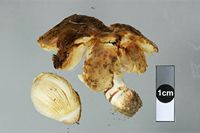
Owner: J.A. Cooper | 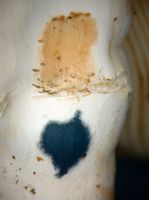
Caption: upper; FeSO4, lowwer: guaiac.
Owner: J.A. Cooper | 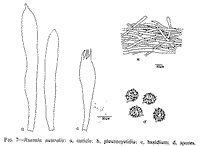 | 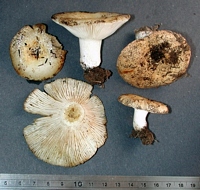
Caption: fruitbody
Owner: J.A. Cooper | 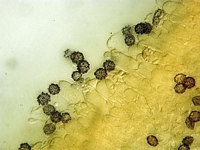
Caption: in Melzer's
Owner: J.A. Cooper | 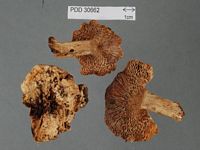
Caption: Dried type specimen
Owner: Herb PDD | 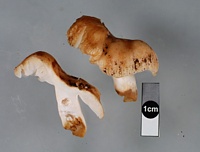
Owner: J.A. Cooper | 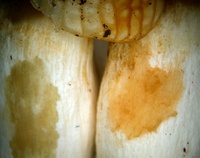
Caption: Top: gill edge. Bottom left: guaiac reaction on stem base. Lower right: FeSO4 reaction on stem base.
Owner: J.A. Cooper | |
Article: McNabb, R.F.R. (1973). Russulaceae of New Zealand. 2. Russula Pers. ex S.F. Gray. New Zealand Journal of Botany 11(4): 673-730 (http://www.rsnz.org/publish/abstracts.php).
Description: pileus: 4-6.5 cm diam., convex when young, centrally depressed to infundibuliform at maturity, slightly viscid under wet conditions, otherwise dry, glabrous, finely felted under lens, velar remnants absent, white to pallid creamy white when first emerging from soil, darkening to cream, creamy ochraceous, or creamy brown, sometimes stained with yellowish brown; margins entire, thick, non-pectinate. Cuticle 200-250 µm thick, composed of repent or obliquely ascending, interwoven hyphae and pilocystidia; hyphae thin-walled, septate, 3.5-6 µm diam., terminal cells unspecialised; pilocystidia sparse, cylindrical to fusiform, thin-walled, apices acuminate or capitulate, contents refractive in KOH, of variable length, 4-8 µm diam. lamellae: adnate to subdecurrent, crowded, moderately thick, simple or rarely forked near stipe, to 4 mm deep, white to pallid creamy white, not discoloured at maturity, lamellulae numerous, typically in partial sequence. stipe: 2.5-4 cm long, ± equal, 1-1.8 cm diam., solid, dry, glabrous, faintly innately reticulate under lens, occasionally pallid brownish white, white; flesh white, unchanging on exposure to air. Cuticle similar to that of pileus; caulocystidia similar to pilocystidia. spores: spore print not obtained; spores broadly elliptical, obliquely apiculate, apiculus to 2-(2.5) µm long, 10-12.5 X 9-11 µm, ornamentation moderately dense, of amyloid or partially in amyloid truncated spines and crests to 1.4-(2) µm high, in confluent groups, joined by moderately coarse to fine amyloid ridges and forming a partial reticulum, or occasionally isolated; plage indistinct. hymenium: basidia hyaline, clavate, 44-63 X 10-14 µm, 4-spored, sterigmata to 8 µm long; pleurocystidia scattered, numerous, broadly subclavate to fusiform, hyaline thin-walled, contents refractive in KOH, projecting to 30 µm beyond basidia, apices bluntly acuminate, occasionally strangulate or capitulate, 63-108 X 8-13.5 µm cheilocystidia numerous, similar to pleurocystidia but shorter. hymenophoral trama: heteromerous, intermixed, oleiferous hyphae occasionally present. context of pileus: white, firm, unchanging: structure heteromerous, clamp connections absent. taste: lamellae mild. chemical characters: formalin on context—n.r.; phenol on context—slowly deep vinaceous; FeSO4 on context—rapidly salmon pink; guaiacol on stipe base—n.r.; KOH on pileus—darkening; on context—n.r.; N4OH on pileus and context—n.r.
Habitat: Solitary or in small groups under Nothofagus and Leptospermum.
Notes: This species appears to belong to the section Compactae subsection Plorantes of Singer (1962) and of Lactarioideae of Shaffer (1964).
|